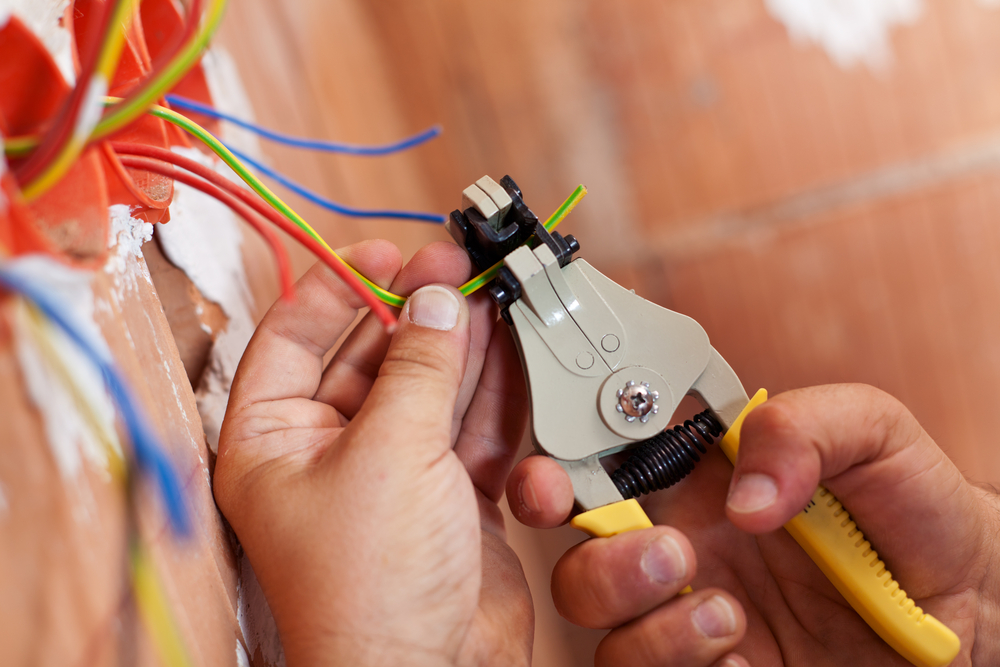Installing new wire in an insulated wall can be a challenge as it usually requires patience and attention to detail. However, most homeowners can do it themselves.
Remodeling projects like adding a thermostat, adding an outlet, and installing security wires often involve “wire fishing”. Wire fishing is a trade term to describe running a wire from one place to another without the benefit of total access.
In walls, fishing a wire vertically is relatively simple, but horizontal fishing requires more effort in most situations.
Here we will describe the process of wire fishing through an insulated wall, the tools needed to do it, and provide some professional advice to make the job easier.
Disclaimer: working with electricity can pose a significant risk to your safety and well-being. In you are not sure about what you’re doing, contact a professional electrician.
What is Wire Fishing?
Wire fishing is the process of running a wire from one place to another after the drywall is installed. Normally, electrical wiring is installed prior to drywall, which allows the wires to be better protected from nails and screws.
As families grow and situations change, sometimes new circuits are required to accommodate a new appliance or fixture. Wire fishing allows a new wire to be run from a source to the new location without removing the drywall.
Can You Fish Wire Inside an Insulated Wall?
You can fish a wire through an insulated wall, but you will likely need a tool known as fish tape. Fish tape is a narrow, semi-rigid flat metal tape wound inside a spool. Most fish tapes are about 25’ long, but they are available in many sizes.
Fish tapes have a small loop bent into the end, which is big enough to accept a small wire, like Romex. The fish tape is rigid enough to force its way through fiberglass batting but flexible enough to bend if it needs to. Most pros twist the fish tape as it travels to prevent snagging on the insulation.
What Tools Do I Need to Fish a Wire Inside an Insulated Wall?
In most wire fishing projects you need your electrical tools of course, but a few others will help.
Here’s a list of the tools you may need to fish a wire inside an insulated wall:
- Measuring Tape and Pencil. You will want to be very accurate with the location of the new hole for the electrical box, so measure the exact spot instead of estimating.
- Keyhole Saw or Utility Knife. A keyhole saw or utility knife will be needed to make the hole for the new outlet in the drywall.
- Fish Tape. A fish tape is specifically designed for fishing wires, so it makes the job easier.
- Strong Tape and/or Needle-Nosed Pliers. You will need to attach the wire to the fish tape, so you’ll need either some strong tape or needle-nosed pliers.
How Do I Fish a Vertical Wire Inside an Insulated Wall?
Before you begin a wire fishing project, you’ll need to decide a path. As mentioned previously, fishing a wire vertically is usually much easier than fishing a wire horizontally. You’ll likely want to approach each direction differently.
To fish a wire vertically, you’ll want to invest in a fish tape. You can sometimes use another piece of stiff wire as a fish tape if the distance isn’t more than a few feet. A fish tape, however, will help with longer wire runs, making the process easier and faster.
1. Define the Path the Wire Will Take
The first step is to find a source of power so you will have a beginning point. You’ll want to ensure you don’t overload a circuit, so consult an electrician if in doubt. You can sometimes get power from another nearby outlet, fixture, or junction box. If these options are not available, you will need to run a wire from a subpanel or the main panel.
2. Measure the Length of the Run
Next, you’ll need a destination. Normally this will be the reason for the new wire, so you’ll need to ensure the destination will work. For example, you’ll want to avoid placing a new electrical box where a stud is located. You will want the new outlet box on one side of the stud or the other, but never in the middle.
Let’s say we want to add an outlet for a wall-mounted television. The problem is that the closest outlet is probably 12” from the floor, so the power cable will show after the TV is mounted.
In this case, you’ll probably only be fishing the wire a few feet, vertically. The goal is to avoid passing the wire through the studs and keep the wire between them as much as possible. In this case, let’s say we need a new outlet 48” above the existing one so the TV will hide the wire. Although we only need 48” of wire, we’ll cut a piece about six feet long to create some slack.
3. Attach the Wire to the Fish Tape
Generally, the easiest way to attach the wire to the fish tape is to expose about an inch of wire from the jacket and insulation. Since the fish tape already includes a loop on the end, most pros simply bend the inch of wire around the loop and twist it tight. You can also use strong tape as an added measure if needed.
You will need to disconnect the existing outlet or junction box from the power source before continuing because you will need to remove the existing outlet to make the connections. After you have created a hole for the new outlet box and removed the existing one, you can fish the wire.
Starting from either hole, push the fish tape and wire towards the other hole. Sometimes you can hear the wire before you can see it, so if needed you can wiggle the fish tape to help you locate it. Fiberglass batts tend to snag the wire, so you may need several tries to find the path of least resistance.
Patience may be required so if you don’t get it the first time, don’t get frustrated. Just keep at it and try different angles until the fish tape appears in the new outlet location. At this stage, the fishing part is done, so you can make the connections and finish the project.
Special Note Regarding Electrical Boxes
In most instances, the installer will use a special type of electrical box when using a fished wire. By most codes, electrical wires must be secured to the framing within 4” of the box. This presents a problem if you can’t nail the box to the stud, as in this case.
A special electrical box is used, known as an old work box. These electrical boxes are usually made of insulative plastic and contain one-way wire support inside the box. These boxes do not require nails but use a clamp instead.
Most electricians will push the wire into the box before installing it, which is the opposite of a normal installation. This method is much easier because you simply push the wire through the one-way clamp, place the box in the hole, and tighten the screws. The one-way clamp feature replaces the requirement for support from the stud, so no hammer is required.
Can I Fish a Wire Horizontally?
You can run a wire horizontally, but in most situations, the easiest approach is to remove the baseboards from the wall. For example, if you wanted to add an outlet 48” from another outlet beside it, you typically have two choices. You can either use a flexible drill called a diversa-bit to drill holes through the studs, or just avoid them altogether.
Using a flexible drill bit in this manner is difficult at best, so a more reliable option is to simply go around the studs by removing the baseboards. Running wires behind baseboards is avoided during new construction, but after the fact, wire installations are made much easier.
The pros will use a utility knife to score the caulk between the wall and the baseboard to prevent accidentally tearing the drywall paper. Next, they use a trim pry bar to gently remove as much of the baseboard as needed. If necessary, the drywall can be cut away behind the baseboard to ease running the wire because the baseboard reinstallation will cover it.
In most circumstances, a strip of drywall is removed to create a channel for the wire. This prevents a hump in the wall when the baseboards are returned. This method is effective, but since the wire is not between the studs, an errant nail or screw can contact the wire and cause a short.
After the horizontal problem is solved, the wire can be fished vertically to its new location. Using this method also prevents fishing wires around corners, which may be the most difficult wire fishing to perform. Remember, when reinstalling the baseboard be careful to miss the new wire.
Frequently Asked Questions: Fishing Wire Through Insulation
Can You Run Romex In Insulation?
Generally, romex is the easiest two or three-conductor wire to fish inside a wall. Because romex has a smooth, tough jacket, it tends to slide easily through fiberglass insulation. However, it’s smart to bend over the end of the wire so it is less likely to snag on the fiberglass.
Can Electrical Wire Go Through Insulation?
Electrical wire can go through some forms of insulation, but not all. For example, romex is easily fished through loose fiberglass, fiberglass batts, or cellulose. However, if your home was insulated with open cell or closed cell spray foam insulation, fishing a wire is likely to be nearly impossible.
Can Electrical Wires Touch Insulation?
Assuming the wire you are fishing is protected by an insulating jacket, it’s fine for the wire to touch the insulation. Theoretically, a wire could overheat if too much current were passed through it, however, building code requirements, like circuit breakers, prevent this from happening.





